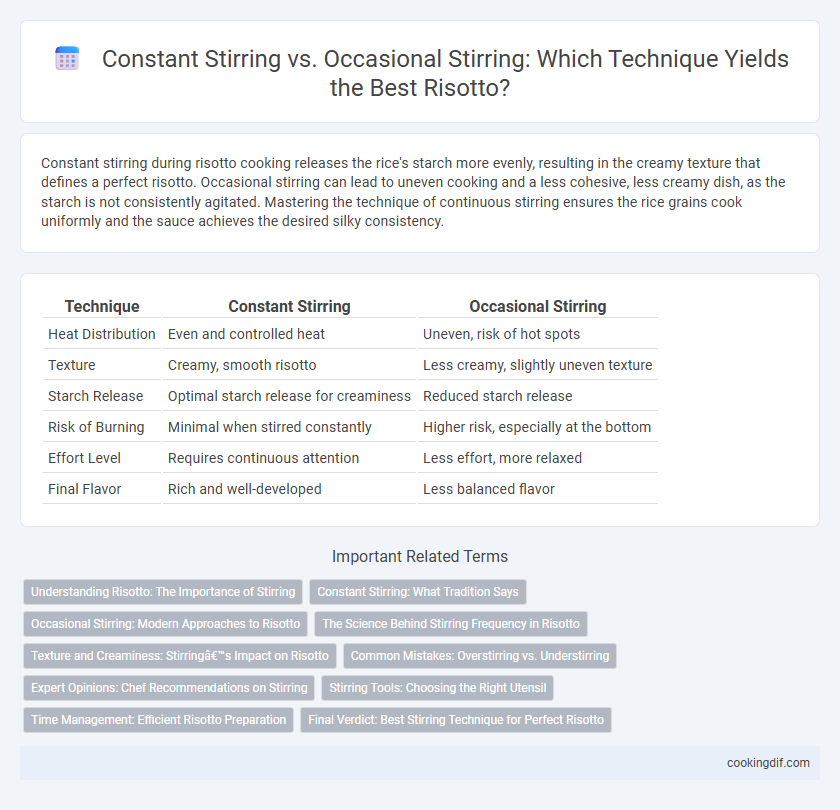Constant stirring during risotto cooking releases the rice's starch more evenly, resulting in the creamy texture that defines a perfect risotto. Occasional stirring can lead to uneven cooking and a less cohesive, less creamy dish, as the starch is not consistently agitated. Mastering the technique of continuous stirring ensures the rice grains cook uniformly and the sauce achieves the desired silky consistency.
Table of Comparison
| Technique | Constant Stirring | Occasional Stirring |
|---|---|---|
| Heat Distribution | Even and controlled heat | Uneven, risk of hot spots |
| Texture | Creamy, smooth risotto | Less creamy, slightly uneven texture |
| Starch Release | Optimal starch release for creaminess | Reduced starch release |
| Risk of Burning | Minimal when stirred constantly | Higher risk, especially at the bottom |
| Effort Level | Requires continuous attention | Less effort, more relaxed |
| Final Flavor | Rich and well-developed | Less balanced flavor |
Understanding Risotto: The Importance of Stirring
Constant stirring in risotto ensures even heat distribution, prevents the rice from sticking to the pan, and helps release the starch needed for a creamy texture. Occasional stirring may result in uneven cooking and a less silky consistency, as the rice can cling to the pan and cook unevenly. Mastering the balance of stirring frequency is crucial for achieving the authentic, velvety risotto characteristic of traditional Italian cuisine.
Constant Stirring: What Tradition Says
Constant stirring is the traditional technique emphasized in classic risotto recipes to ensure even cooking and the gradual release of starch from the Arborio rice, creating a creamy texture. Continuous agitation prevents the rice from sticking to the pan and promotes uniform absorption of broth, enhancing flavor infusion. Chefs focusing on authenticity maintain that abandoning constant stirring risks uneven texture and underdeveloped risotto creaminess.
Occasional Stirring: Modern Approaches to Risotto
Occasional stirring in risotto preparation reduces the risk of over-agitation, allowing rice grains to release starch gradually for a creamier texture. Modern culinary techniques emphasize controlled heat and precise liquid addition, enhancing flavor infusion while preserving the rice's al dente integrity. This method conserves energy and minimizes constant attention without compromising the traditional risotto's signature creaminess.
The Science Behind Stirring Frequency in Risotto
Constant stirring in risotto promotes the gradual release of amylopectin from Arborio rice, resulting in a creamy, cohesive texture by evenly distributing starch throughout the dish. Occasional stirring, however, risks uneven cooking and clumping by allowing starch to settle and stick, which compromises the risotto's signature smoothness. Scientifically, frequent agitation maximizes surface area exposure to heat and liquid, optimizing starch gelatinization and creating the ideal rich consistency.
Texture and Creaminess: Stirring’s Impact on Risotto
Constant stirring during risotto cooking promotes gradual rice starch release, resulting in a creamier and smoother texture with enhanced silkiness. Occasional stirring, while less labor-intensive, may lead to uneven starch distribution, producing a less creamy and slightly grainier consistency. Achieving the ideal risotto texture relies heavily on consistent agitation to maximize starch extraction and emulsify the liquid evenly.
Common Mistakes: Overstirring vs. Understirring
Constant stirring during risotto preparation ensures gradual starch release, creating a creamy texture, but overstirring can break the rice grains, resulting in a mushy consistency. Occasional stirring allows the rice to absorb liquid evenly, yet understirring risks uneven cooking and grain clumping. Balanced stirring techniques optimize starch release and heat distribution, essential for achieving an ideal al dente risotto.
Expert Opinions: Chef Recommendations on Stirring
Expert chefs emphasize constant stirring in risotto to achieve a creamy texture by promoting gradual starch release from the Arborio rice. Occasional stirring risks uneven cooking and a less cohesive consistency, as starch doesn't fully emulsify. Top culinary professionals recommend maintaining steady agitation to create the classic velvety finish integral to authentic risotto.
Stirring Tools: Choosing the Right Utensil
Constant stirring with a wooden spoon ensures even release of starch in risotto, creating a creamy texture, while occasional stirring may cause uneven cooking and clumping. Choosing a flat-edged wooden spoon or silicone spatula provides optimal control and prevents damage to the pan's surface. Metal utensils may scratch non-stick pans and disrupt grain cooking, making wooden or silicone tools the preferred choice for perfect risotto consistency.
Time Management: Efficient Risotto Preparation
Constant stirring during risotto preparation ensures even heat distribution and prevents the rice from sticking, resulting in a creamy texture, but can be time-consuming. Occasional stirring saves time and allows the rice to absorb liquid more steadily, though it risks uneven cooking and a less cohesive consistency. Balancing stirring frequency optimizes both texture quality and efficient time management in risotto cooking.
Final Verdict: Best Stirring Technique for Perfect Risotto
Constant stirring ensures the rice releases its starch evenly, resulting in a creamy, smooth risotto with a consistent texture. Occasional stirring risks uneven cooking and can lead to clumpy or unevenly creamy results, compromising the dish's traditional richness. For achieving the perfect risotto, constant stirring remains the best technique to maximize starch release and maintain the ideal consistency.
Constant stirring vs occasional stirring for technique Infographic

 cookingdif.com
cookingdif.com